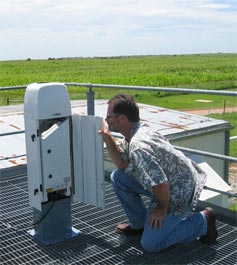New Ceilometer Evaluated at Southern Great Plains Site
Published: 15 August 2008

To analyze cloud properties, ARM scientists use data from an instrument called a ceilometer. This instrument transmits pulses of light into the sky and receives return signals to measure scattered radiation, cloud base heights, and visibility. In preparation for a pending upgrade to the instrument, operations staff completed a field campaign at the ARM Southern Great Plains (SGP) site to evaluate the new ceilometer against the current model, as well as against other instruments that measure similar properties. From June 15 to July 18, the new model was deployed alongside the current ceilometer and Micropulse lidar at the SGP site. In addition to comparing and contrasting measurements against the lidar, measurements of mixing-layer height from the new CL31 will be compared to measurements obtained by the SGP’s balloon borne sounding system during the same time period.
Improved techniques for measuring cloud properties and the ability to support these observation systems beyond 2010 are critically important to understand and improve the performance of global climate models. ARM uses ceilometer model CT25K at all its sites, but they are approaching the end of their supportable lifetime, with repairs getting more and more expensive. The ceilometer manufacturer, Vaisala, recently released a new model, the CL31, which includes additional capabilities such as a newly developed algorithm for mixed-layer cloud detection. The CL31 demonstration will help ARM to develop instrument requirements and specifications for replacement of the CT25Ks. Data from the instrument comparison are being analyzed by Vaisala and researchers at the University of Iowa, who are interested in the instrument for application to carbon cycle research.
The ARM Climate Research Facility is a DOE Office of Science user facility. The ARM Facility is operated by nine DOE national laboratories, including .
Keep up with the Atmospheric Observer
Updates on ARM news, events, and opportunities delivered to your inbox
ARM User Profile
ARM welcomes users from all institutions and nations. A free ARM user account is needed to access ARM data.


















